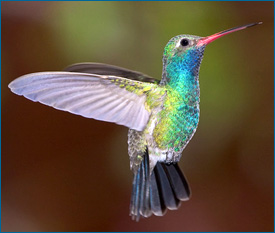
Kim’s work is also taking her in a surprising new direction: to the movies. She’s recently teamed up with Todd Harvey to learn more about iridescent feathers. Todd, a computer scientist turned zoology graduate student, specializes in outer coverings: he had helped animate the skin of Gollum in the Lord of the Rings series and the hair of King Kong in King Kong, among other projects. Todd’s interest in improving the modeling of feathers in movies inspired him to look much more closely at this aspect of birds’ biology, and through their collaboration, Kim found herself looking at birds in a whole new way. She was intrigued to realize that the heart of iridescence is its directional nature: iridescent objects look different depending on the angle at which they are lit and viewed. Kim and Todd realized that this property of iridescent feathers could be used to send signals that could be seen at some angles but not others, potentially providing a mode of “private” communication. This ability might, for instance, allow a male hummingbird to wow a particular female with a bright flash of color and light without alerting predators in the process.
As in Kim’s work on manakin wing sounds and mating displays, the first step is simply understanding what is happening, documenting the angles that the feather filaments (called barbs) and their subfilaments (called barbules) branch off of the feather and what these angles mean in terms of light reflection and absorption. But, of course, given Kim’s curiosity, her next step will be to investigate the question that has always driven her: how did it get to be that way? And answering that will mean taking the same approach that she did for the manakins: deconstructing iridescence into its components and mapping these components onto a phylogeny to determine which aspects of the trait are homologous and how the trait evolved over time. For Kim, this trail of questions leading from one to the next is one of the great joys (and frustrations!) of doing science. Says Kim, “Every time you figure something out, it highlights something else that you don’t understand!”

Besides her responsibilities as a teacher and scientist at Cornell, Kim also has a responsibility to her family. The mother of two young children, ages six and one, Kim often needs to find creative ways to combine work with the rest of her life — like giving a lecture with a sleeping infant strapped to her back. Although she had some reservations at first, she says people have responded very supportively: “People have come up after these lectures and cheered me on, saying they were so inspired to see me even attempt this. I think it tells us something about the willingness of society to adjust to help people balance family life with other aspirations.”
Discussion and extension questions:
- In your own words, explain what homology is. Give one example of homology not described in this article.
- In your own words, explain what homoplasy is. Give one example of homoplasy not described in this article.
- What evidence supported the idea that elements of the club-winged manakin’s display were homologous to elements in the displays of some Pipra species?
- What evidence would have suggested that those display elements were non-homologous?
- Use the character matrix below and the phylogeny from the article above to answer the following questions:
Makes wing noises Club winged Manakin Yes Fiery-capped Manakin Yes Striped Manakin Yes Red-capped Manakin Yes Golden-headed Manakin No Red-headed Manakin Yes White-crowned Manakin No Wire-tailed Manakin Yes Band-tailed Manakin Yes Crimson-hooded Manakin Yes Blue-crowned Manakin No Dwarf Tyrant-manakin No - Sketch the phylogeny of the manakins and mark the position of the most recent common ancestor of the club-winged manakin, the fiery-capped manakin, and the striped manakin.
- Is it likely that that common ancestor made a noise with its wings? Explain your reasoning.
- Map the wing-noise character onto the entire phylogeny, and sketch the most parsimonious mapping. How many character state changes are involved? Is there only one mapping that involves this number of changes? If there is more than one, sketch the alternative mapping.
- What evidence would help you determine which mapping is more likely to represent the true evolutionary history of this group?
Get tips for using research profiles, like this one, with your students.
